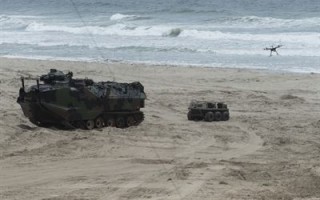Joint Navy and Marine exercise demonstrates amphibious autonomous warfare
NewsMay 11, 2017

MARINE CORPS BASE CAMP PENDLETON, Calif. A recent exercise held at Camp Pendleton demonstrated emerging technology innovations in the area of autonomous amphibious warfare.
Interested parties from industry, academia, and the Naval Research and Development Establishment -- which includes the Office of Naval Research (ONR) and various research laboratories associated with the Department of the Navy -- conducted Ship-to-Shore Maneuver Exploration and Experimentation Advanced Naval Technology Exercise 2017 (S2ME2 ANTX) with a cast of hundreds of sailors, Marines, and Department of Defense (DoD) civilian employees and contractors.
S2ME2 ANTX focused on five capability areas of amphibious operations: ship-to-shore maneuver; weapons fire support and effects; clearing assault lanes; command and control; and information warfare. During the demo, unmanned and autonomous vehicles equipped with sensors gathered intelligence in the air, on land, and underwater. During each amphibious beach demonstration, unmanned surface vehicles and unmanned underwater vehicles (UUVs) approached the shore first, collecting intelligence about threats and obstacles in the imagined battlespace, thereby providing an accurate picture of what warfighters would face when leaving their vessels and vehicles.
One of the ONR and Naval Research Laboratory-sponsored projects demonstrated at S2ME2 ANTX was the BEMR Lab, with BEMR standing for "Battlespace Exploitation of Mixed Reality." This tool combines virtual reality, or complete immersion in a simulated or virtual world, with augmented reality, in which virtual objects are imposed onto real-world vision through Oculus Rift goggles. Another project demo was the Mine Warfare Rapid Assessment Capability, in which a small quadcopter is outfitted with an ultrasensitive magnetometer and sensors to detect mines and provide real-time data to a handheld Android device.
Another demonstrated project was the Coalition Tactical Awareness and Response system, which system uses satellite imagery to conduct surveillance of large areas of open ocean; the system then processes image data to generate detailed reports about maritime activity in the areas surveilled and then shares the information with partners and allies.
Technologies that performed well at S2ME2 ANTX have the possibility to be featured at Bold Alligator 2017, a multinational series of amphibious exercises led by U.S. Fleet Forces Command and U.S. Marine Corps Forces Command, which is scheduled for fall of 2017.






